Thanks for sharing thoughts, they are helpful.
thanks for the suggestion! never heard of plinky, they make some really cool stuff!! the blueberry touch seq looks really neat as well
anything out there like a synton fenix iii in eurorack modular 3.5mm format? i have a tiptop z8000 which is cool.
imagine a synton fenix3 crossed with the tiptop sequencing modules in eurorack format, that would be on everyone's wish list for sure. an 84hp all in one sequencer. the good thing about the tip top is you can derive 10 different cv sequences from one grid of 16 values. and the fenix3 has all the additional modules you need for sequencing. it's a shame there fenix is so rare and a shame that sequencing modules are always compressed into as small a space as possible. you could do a lot with an 84hp sized module. there's a company called 2hp, so why can't there be a company called 84hp that does kick arse sequencers?
this koma komplex looks fantastic but isn't eurorack mountable.
i really dig this one :)
https://modulargrid.net/e/crey-emporium-bib
https://modulargrid.net/e/intellijel-%C2%B5midi-jacks
this I mean.
As for a case, you can go a lot cheaper DIY. Check out my "SUITCASE". it is literally a 20€ suitcase from ebay. I screwed three rails in from exploding shed and used a power module with flying busboard. Costed less than 200€. You can just buy a few rails and build a box around it in any way. On the other side: If you spend 5k for a system, 10 percent for a decent case seems alright too. Some good stuff on ETSY.
hi all, heres my sound making hobbyist type rack vaguely tailored towards broad 'genres' such as techno/breakbeat/idm/ambient. Current plan is to sequence with a beatstep pro and use the ES-9 to make this a hybrid setup in VCV. was curious about everyones impressions, comments/critiques and any ideas for fun/quirky 1U modules that would gel well
thanks :)
Great, I used the dual dagger as this was silver (I know lol)
I wasn't sure what you meant about the midi, so I used the left over 2u on a midi module
I know what you mean about the funds The calculated price is shocking! and that's without a case. I was thinking of the "Too many synths 10u" case.
So I would buy the case and the minimum of modules first and then add them as funds allow.
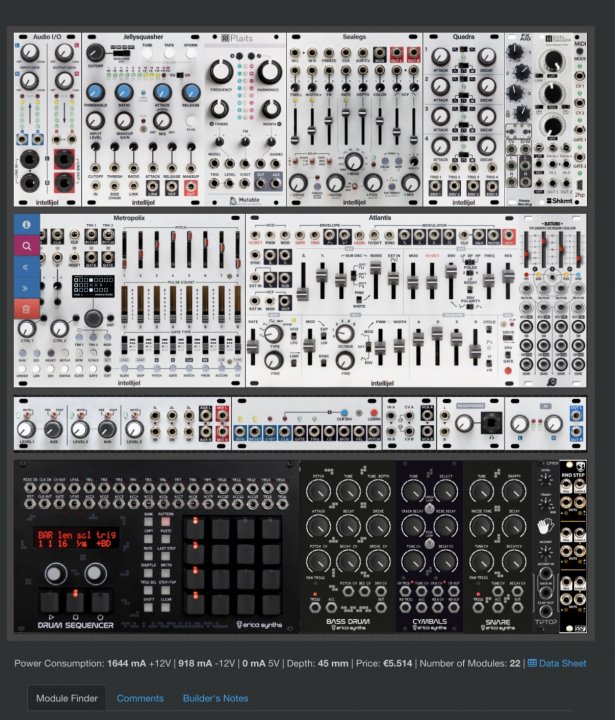
You still need the Midi Jacks from them actually, they connect on the back.
I love the big knobs! Check out the Ikarie Filter though. Everyone is crazy about it these days. It has stereo capabilitys and a built in VCA. This could pair well with the AUX and OUT of your Plaits and the Quadra. Or maybe the Dual Dagger Stereo Filter. This has a HP filter that also processes the signal. That way you can already cut some of the low end and have a cleaner mix/patch. The Ikarie has an HP too though, I do not have the funds atm so i did not go into it too deeply. But I will get either of those next year probably.
Fantastic advice, thank you so much.
Ok, I've made a few mods and made things fit ;-)
I'm not sure about the forms filter I've added?
See what you think.
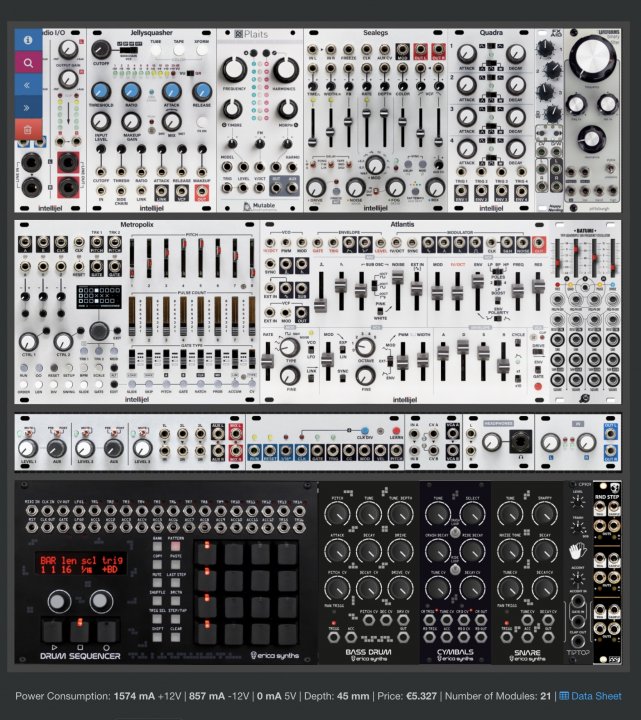
I think you made a good decision with the changes.
Recently I am thinking to switch my 909 Hats for the Erica Cymbals. They are super versitile and produce very decent hats as well. I use the Modbase Kick for the booom but if I did not have it already I would probably go for the Entity Kick.
Seriously get a DivKid RND STEP. It gives constant modulation and is great to keep voices alive, especially drums imho. It is doing its thing in every patch and track I make. Attenuators help keep it in a reasonable range (Quad Atten or Junction, but you might wanna go for a 1u version).
I reconsidered one of my advices. Pamelas Workout is great , but it is a complex module that needs deep diving to use it imo. Since this is your first system, I would highly recommend cutting complexity where possible. Might wanna go for a Batumi II or a 4ms pingable quad LFO. This is a very personal opinion though.
When I bought my first system I was pretty overwhelmed (though it took me years to actually acknowledge that). Every module has so much potential and funktions, endless possibilitys but I always ended up doing the same things or I got stuck at complexer and menu heavier modules and it interrupted my flow.
My philosophy now is to avoid menus and have everything at the surface and the tip of my Fingers, it is immidiate and more fullfilling. Pamela is great, especially in smaller systems, but it might be a brick in yours for the start.
You dont need the scope :) Its just a gimmic imo.
A Midi connection I recommend strongly if you plan to arange and edit in the DAW so the DAW can be your master clock.
Most importantly: A system is never finished. There will be constant change so do not be afraid to buy th "wrong" module, you can always sell again. You will find your prefrences and those will change with time. Enjoy the ride :)
That said, I am curious to hear it when its done.
Thank you very much for your advice!
i've taken your ideas on board and made some mods. The Intellijel VAC 1u was only available in dual rather than quad so I added that. I still have a few spaces left :-)
Anything else younwould recommemd to fill the slots?
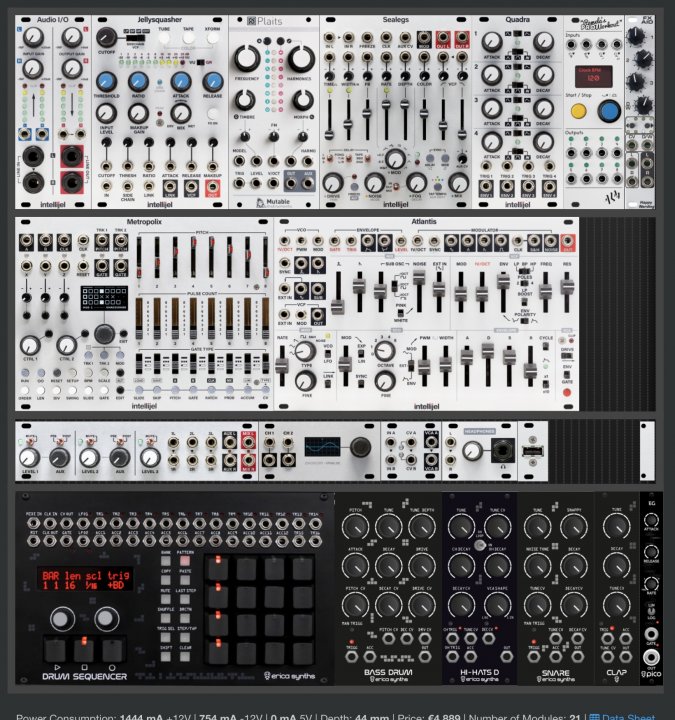
Love the rack, you pu some thought in it!
Get a few LFOs and some more envelope. Math would serve you well or the quad envelope by intellijel. You might wanna get their quad VCA too sincethe have it in 1u. You got the sealegs, so I do not know why you need the springray. Maybe a choice of taste? If you want more flexibility on effects get an FX aid, can't do nothing wrong there. Some random sources, DivKid RND (and OCHD LFO) might be neat. If you want to be flexible on CV because you do not know where the journey takes you consider Pamelas new workout or Octocontroller. Where do you mix your signals?
That is my humble opinion anyways :)
Hi,
I'd value your opinions on my proposed first modular.
I've only experience in DAW's and the odd beatbox. I really want my first modular to be a decent set up so I'm not needing to upgrade the case etc. I'm lookimg for somethimg similar to a beatbox as sequencing is my thing.
I'm. bit confused to what utility modules I need, and if im missing anything vital. As you can see, I have a few slots available :-)
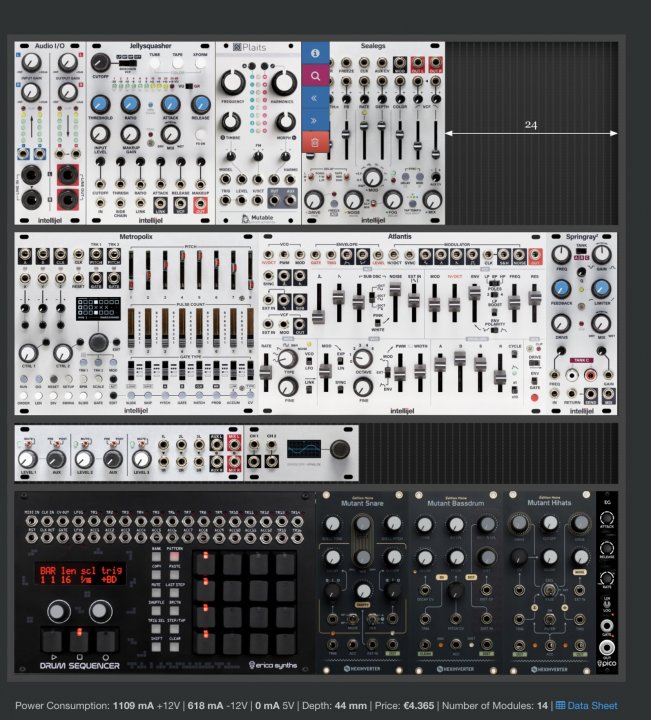
Hi,
just started recording stuff again because oooummph.
I will keep this format for future tracks. Would also be curious to hear other peoples live takes and what they made of it in the DAW afterwards. Feel free to post here.
2nd live recording:
?utm_source=clipboard&utm_medium=text&utm_campaign=social_sharing&si=dc911987a983483bbb915ed5ed924212
Single track recording and editing:
_source=clipboard&utm_medium=text&utm_campaign=social_sharing&si=961ddb0f6e9742dc80e63a4258c9bbad
Hate to say it, but the ableton version is more of banger. Has a lot more work gone into it of course.
Choke is my favorite!
V1: patched as shown. Left loose cable takes external clock. VCF Freq between 1 and 10. VCF FM between 0 and +5. VCO Mod index between 1 and 10. Megaslope stages 3 and 5: for a FM glide, set to 10, at all other time set to 0.
V2: Channels 1 and 2. Left loose cable takes external clock. Remove Complex oscillator v/oct and insert right loose cable. Dixie FM1 MUST be set to approx 2 o'clock.
Hi,
https://www.modwiggler.com/forum/viewtopic.php?t=292855&hilit=Beers
Maybe you can have some usefull advice there.
wow that looks fantastic
on the left of the beers module, there are binary number inputs, what do they do?
is there only 1 clock input? individual clocking would have been useful
Percall needs noise plathora :-) Patterns from Patching Panda, 16 presets by cv - nice
Beers does something similar
https://modulargrid.net/e/beers-bigger-dumber-sequencer
Enjoy your spare HP, don't rush to fill every last space, this is not like filling sticker books. Resist the urge to 'complete' your rack, its never complete so just relax.
hi,
does anything like this exist? i guess oberkorn
looking for something cool like this
Everyone loves the classics, but I'd definitely ditch some of the tiptop modules in favour of something more modulatable. BIA is the canonical choice, but I'm sure there's plenty others. Otherwise, looks like a lot of fun.
Latest stuff : https://soundcloud.com/user-352590333
A great controler/recorder/attuantor and a lot more.
Tho' another one of my videos that won't show up in MG's serpapi (google search api)... which is totally weird, so as long as this lasts, I'll publish the videos on here (forum) so that it DOES pop-up in the module's page. Sorry for that guy, Knut "MG" is now aware of the issue, and youtube too (partner) ;)
Our full walk-through is available here
;)
cheers to all!
Shakmat is a modular synthesiser company based in Brussels, Belgium. We create modules pushing musical expression and creativity forward.
Setting up a box for Synth Camp 2025 - I'm doing beats this year - I want ordered-chaos.
This patch is the basic patch for Eat Sleep Beat Repeat:
1. Pam's main clock to O+C which is in EuclidX (x2) in Phnazerville Suite
2. Acid Rain Junction attenuverting 5v on 4 channels into O+C to control Euclid Fills
3. Euclid beats from O+C into Quad Drum with internal CV/LFOs for accents etc (and lots of other quad drum goodies).
4. Basic beats (maybe euclid again) from Pams into Pico Drums set as Open and Closed hats
5. Main Clock from Pams into BIA, then various modulation from Pique into BIA decay etc (may use some pams here too)
6. All outs into Happy Nerding Mixer
7. Main outs into Typhoon set to Beat Repeat with some of Pam's CV outs to modulate various
Concerns:
1. power hungry (although I have 2x 99Wh batteries which I can charge if I go off site to a pub)
2. no headphone jack... (I could make a little headphone amp to take with me)
3. Limited FX and/or filters (but I feel the Typhoon makes up for that)
4. Compression/side-chain missing may mean be limiting (but I can us QD compressor internally, and I can route the kick independently from it if I want as I have a spare mixer input, and I'm not really planning on any stereo from the QD)
Any thoughts on changes, patch ideas,
Avalon Harmonics Kickaid
https://modulargrid.net/e/avalon-harmonics-kickaid
Dear all,
I'm super excited to share with you the release of the EP How to Make it Fit by the duo MNPL.
In line with the label’s artistic direction, this EP was performed and recorded live on January 13th and 14th, 2025, at MNPL's studio in Mons (Belgium).
This duo from Mons puts great care into performing fully improvised sets.
As a big fan of modular synths, techno, and live acts, I was immediately struck by the sound and energy of their live performances. The track names on the EP—Clench, Melt, Choke, Dilate—perfectly illustrate the sound design and textures at the heart of their music: deformation, transformation, stretching, shrinking. Their approach breaks away from conventional patterns, quickly moving beyond the usual random 16-step lead phrases often heard in improvised techno—only to return to them with impact when it counts. You lose your bearings; time stretches, to our greatest delight.
Subtle melodies emerge from waves of noise with carefully crafted harmonies, bordering on post-industrial. The kicks and subs have a hypnotic groove. The whole thing is at once powerfully aggressive and surprisingly gentle, held in balance by their masterful control of tension throughout the improvisation. A music of contrast, with its own originality.
Since the artistic direction of the label—focusing on music that is played and performed live—aligned perfectly with their workflow, we decided to collaborate on this EP. We did a two-day studio session and recorded a bunch of jams. Watching them work, it becomes clear why their live improvisations feel so complete: they communicate almost without words—through gestures, brief glances. The dialogue is carried by the sound, by the tension, and each knows where they are, and where the other is going.
We selected four tracks with very distinct directions, captured on the fly. The mixing was done by Mesomorph at Studio Morph Brussels, who delivered an absolutely remarkable sound job, and the mastering was handled by Pattrn at Incidence Studio, giving the tracks their final depth and dimension.
Wishing you a great listen and a safe trip through MNPL’s sonic madness!
Valentin Rocher
The OCHd expander is actually four hp, not two as I stated. Been a while since it is not in the rack I'm currently working on.
Still -- lots of lfo / trigger additions on it.
As you may know, the video is in French but I did English subtitles :)
Sorry for posting in the forum but I got sort of "filtered" since a few months on the search API on here, and I humbly think some souls may be interested in it (the video) and of course me I'm interested in more views aswell.. So as long as the issue stands, I will systematically make such publications, to make sure my work is viewable here ;) ;)
The choices which region offers should be displayed in the marketplace are now saved.
Beep, Bopp, Bleep: info@modulargrid.net
sure, but shouldn't it be simpler? sometimes, it feels weird. "the internet" is perfectly capable of storing, analyzing our every move, reflected in ads and served content everwhere. but saving an actual deliberate choice? sorry, that's rocket science. not to diss modulargrid, but it's something i find odd not just here.
-- blingistan
ModularGrid does not track your steps in the internet but since today we save your Marketplace region choice :)
Beep, Bopp, Bleep: info@modulargrid.net
I have the Indian Resonator from Error Instruments and the new Bloom v2 (excellent!), so we must have some common tastes.
Haven't tried the Brinta, but I do have their White Rabbit, which I highly recommend, along with you adding the
expansion to DivKid's OCHD! Only two hp and has a lot of added punch.
-- halbroome
The Indian Resonator is great and am a big Error Instruments fan. Yes the White Rabbit looks great and would like it one day but already have the FX Aid pro. Thanks for pointing me in the direction of the OCHD expander, I will have to look into that.
Thanks for the advice.
I have the Indian Resonator from Error Instruments and the new Bloom v2 (excellent!), so we must have some common tastes.
Haven't tried the Brinta, but I do have their White Rabbit, which I highly recommend, along with you adding the
expansion to DivKid's OCHD! Only four hp and has a lot of added punch.
I'm about to update my drum rack from modules I already own, this is a mockup of a possible config;
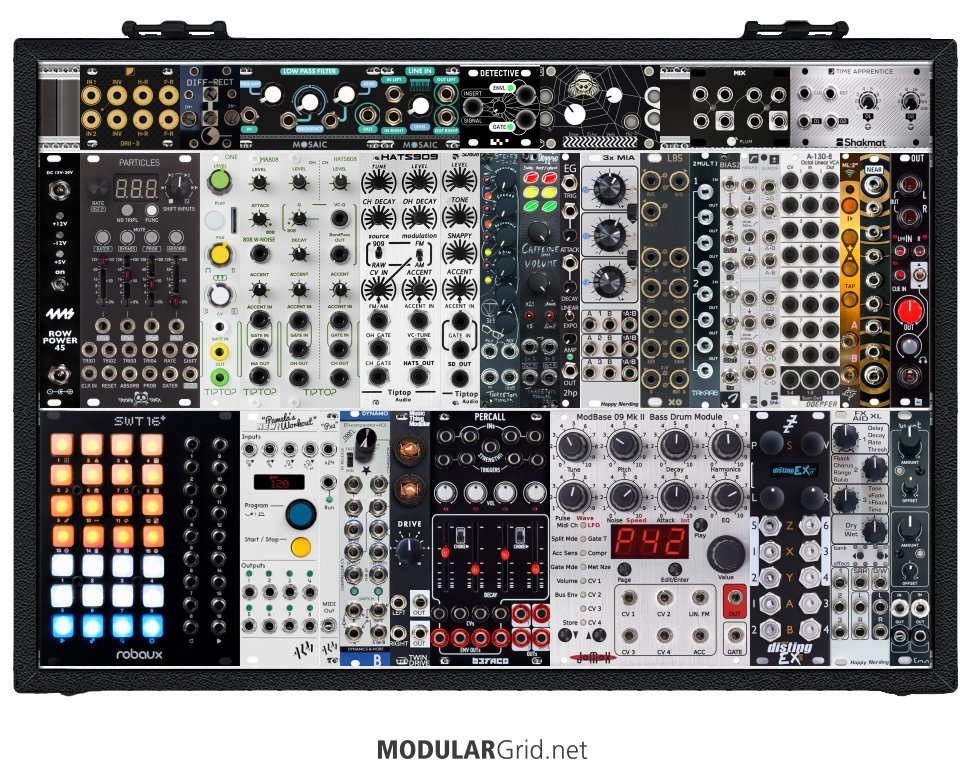
This is the current config;

I still like the Tiptop Audio drum modules because they sound goood, they are important in these setups.
general opinion:
+ lots of trigger control
+ sufficiant dynamic control
I would love to hear opinions,
Cheers!
I would love to hear it :)
Effects next? You use pedals or VST?
Thanks Rolling-Rat for the response, I had half made my mind up on The Brinta but always like to hear peoples views. What you see in my rack is what I own so no Bloom 2 for me for probally a long while.
To gain some more hp back I will change Brains for the Big Music T version as it's half the size and then I have space for something quirky in the future.
Ladik's website doesn't mention 70mA on -12V. http://ladik.ladik.eu/?page_id=2786
VCO out should go to the audio in of the Wasp filter. The out of your Tilt should go to the CV input of the Wasp and Gristleizer (for a classic subtractive patch). Out of the Wasp into the Gristleizer input. Gristleizer output into your mixer. Adjust settings of Gristleizer bias and Wasp level and frequency to taste.
Have fun!
HI and welcome! we have similar taste in music, I play drum in a punk/hc band and also make industrial/PE ;-)
Make sure you are transmitting and receiving on the same MIDI channel from keystep to the Doepfer A 190-3
Hope it helps
I feel stupid and I've been avoiding asking the internet for help, because people are assholes. but after a few weeks of getting nowhere, I need to reach out. I mostly make power electronics on my own, play synth and bass live for an electro-industrial project, and when I jam with friends hardcore and crust punk. I always wanted to get into modular synths and eurorack, but never had the funds. this year, I read into eurorack and modules and ordered what I needed for a basic set up, leaving myself room in case to add much more later.
I have used semi-modular synths before. I've made sure all of my modules are plugged in correctly. with the Behringer Euro Go, it's pretty hard to fuck it up but I still made sure. when I go to patch, I just don't get any sound except from the mixer. if i patch the vco to the mixer, i can get some sound from the vco, but that's it. I tried watching videos to see what I'm fucking up and I've made sure to read all my equipment manuals. I've used my keystep 37 with my TE Medieval, but I can't patch it correctly to my eurorack. I've included photos but what I have:
Behringer 112 (vco), Doepfer Wasp filter, After Later Audio Tilt (function generator), Future Sound Systems Gristlizer TG4 (vca), Behringer 305 (mixer/sound source), Doepfer A-190-3 (midi-to-cv/gate). I also have delay and reverb modules but haven't touched those yet. and if you can't tell from the photos ;
keystep 37 midi to the gate
gate > gate input on function generator
pitch > vco input
cv note > vco input ( also tried adding velocity to vco input but it's not pictured)
vco out > cv 1 on filter (also tried audio in)
filter lp/hp out > vca input
vca out > mixer input
function generator out > mult >filter audio in and vca cv1
What am I doing wrong? am I missing something. I don't have any friends into modular, so you guys are my best hope.
Hi!
Brinta is brilliant!! Would be a good choice!
I I may add further - unwanted ;-) - commentary:
Wait for the Bloom V2, should be a huge step up!
And, you can't really go wrong with Plaits/Brains, but I wonder whether it might be more fun to add a dual osc analog voice like Archaea Loki or or so. But that is obviously a very personal choice and investment. (And trends show having both anyway ;-)
In any case, have fun!!
Hi!
Brinta is brilliant!! Would be a good choice!
I I may add further - unwanted ;-) - commentary:
Wait for the Bloom V2, should be a huge step up!
Any, you can't really go wrong with Plaits/Brains, but I wonder whether it might be more fun to add an analog voice like Archaea Loki or so. But that is obviously a very personal choice. (And trends show having both anyway ;-)
Have fun!!
hi,
Here is the audio input wiring on a Grone Manecolin that has problems with its runglers - could this be the cause?"
the runglers stops randomly
I am feeling the need to purchase one more module - I have been good so far and not bought anything this year BUT I have been drawn in by the Brinta by Error Instruments. My set up ambient / generative, with ST Modular Radio as a fun voice and 2HP loop to record it or Endless Processor.
Error Instruments Tassel I feel looks great but will not hold as much enjoyment and use as Brinta.
Do you think it would be a wortwhile addition to my rack?